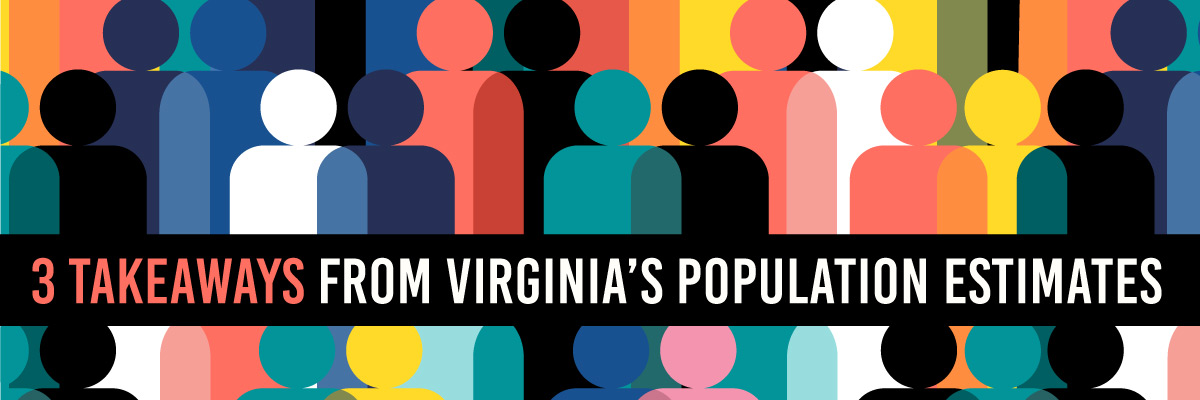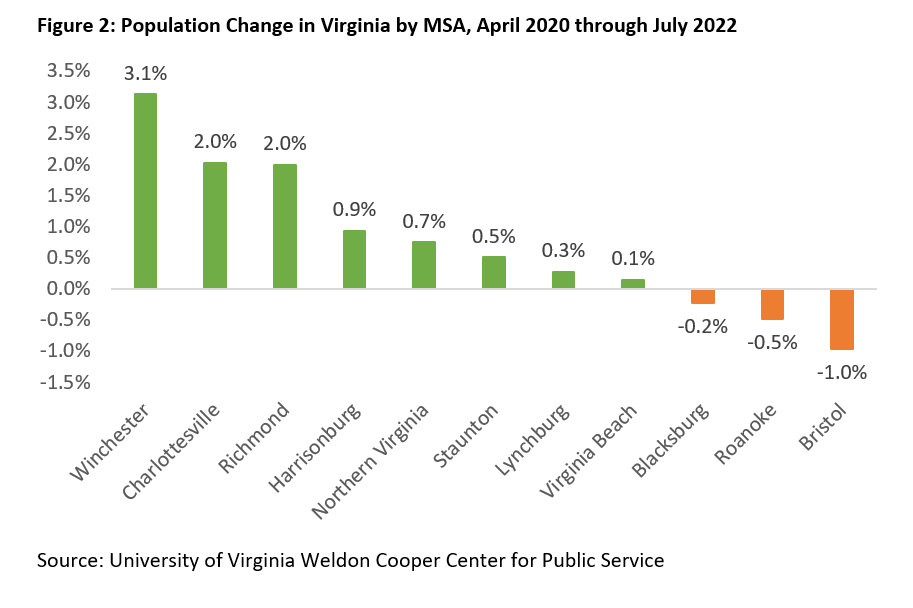3 Takeaways from Virginia’s Newest Population Estimates
June 26, 2023

Each year, the Demographic Research Group at University of Virginia’s Weldon Cooper Center develops and releases the official population estimates for Virginia and its counties and independent cities based on American Community Survey estimates. Population estimates are an important tool used by a variety of state agencies in their planning processes such as developing budgets and resource allocations. This data can also be used to understand the changing demographics of the population and how to best serve their needs. Below are some of the highlights from the recent population estimates as of July 1, 2022, spanning the change from April 2020 through July 2022.
1. From 2020 through 2022, population growth slowed down in Virginia as compared to the period from 2010 through 2012.
Between 2010 and 2012, Virginia’s population grew by over 185,000 but during the first two years since the 2020 Census, Virginia’s population grew by only 52,000. We still have more people living here, but the gain has gotten smaller and smaller over time. Between 2010 and 2012, Northern Virginia added 115,000 new residents but since 2020 it has only grown by 23,000. In 2022, the population of Northern Virginia’s older suburbs, concentrated between Arlington and Manassas, where most Northern Virginians live, was smaller than in 2017. Virginia Beach MSA’s population grew by a little over 2,000 in the two years since 2020, which is lower than its population growth of about 29,000 between 2010 and 2012. On the other hand, the population in the Richmond metro area grew by 26,000 since 2020, which is a slight increase from its population growth of 25,000 between 2010 and 2012.
2. Most of Virginia’s growth has been concentrated in the suburbs and exurbs of Richmond and Northern Virginia.
Since the 2020 census, most of Virginia’s cities have lost population, but localities located on the edge of metro areas have grown fast. The three fastest growing localities in Virginia were all located on the edges of the Richmond Metro Area, which has grown more than any other Virginia metro area since 2020. In Hampton Roads, Suffolk has been one of the few localities growing faster than Virginia as a whole. And, in Northern Virginia, Stafford was the fastest growing locality. Because of remote work, or at least hybrid options, people can live much further from their central offices in major job centers. This has allowed population to grow in Virginia’s rural and exurban counties that may have more housing options, and in some cases lower price points than the urban and suburban markets.

3. Outmigration is the primary reason for the slowdown in population growth in Virginia.
Many Virginia residents have left the Northern Virginia area, specifically, to move to the Sunbelt states such as North Carolina, South Carolina, or Tennessee, among others. Along with fast growing metros, in some cases these states have lower tax rates, more affordable living costs, and more importantly, housing options. Up until just a few decades ago, Virginia was a significantly more affordable state to live in as compared to most northeastern states. However, over the past couple of decades, home prices in most places in Virginia rose faster than the rest of the country. This has caused affordability concerns for younger people who are looking to start families and buy homes. Even within Virginia, Northern Virginia residents have chosen to move to various parts of the state. Migration from Northern Virginia into the Richmond Metro area has risen by nearly 40 percent since the mid-2010s. Metro areas such as Charlottesville, Richmond, and Winchester have seen an influx of Northern Virginia residents moving there.

For more information on housing, demographic and economic trends in Virginia, be sure to check out Virginia REALTORS® other Economic Insights blogs and our Data page.
You might also like…
Midway Through 2024, Virginia Home Sales Activity Slightly Outpacing Last Year
By Robin Spensieri - July 24, 2024
According to the June 2024 Virginia Home Sales Report released by Virginia REALTORS®, there were 10,018 homes sold across the commonwealth last month. This is 974 fewer sales… Read More
Three Multifamily Market Trends from the Second Quarter of 2024
By Sejal Naik - July 16, 2024
Each quarter, through its Multifamily Market report, the research team at Virginia REALTORS® analyzes the trends and changes in the multifamily market. Here, we share the key highlights… Read More
Takeaways From the JCHS 2024 State of the Nation’s Housing
By Dominique Fair - July 15, 2024
The Joint Center for Housing Studies from Harvard University released this year’s State of the Nation’s Housing report highlighting the impact today’s market is having on both homeowners… Read More